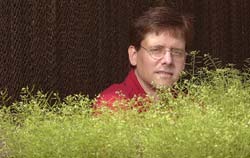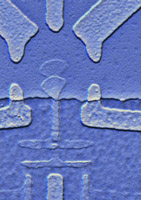
The identification and duplication of a gene that controls production of plants’ outermost protective coating may allow Purdue University researchers to create crops with increased drought resistance.
Scientists cloned the gene WAX2 after they discovered a fast-wilting mutant of Arabidopsis, a commonly used experimental plant. The gene is directly associated with the synthesis of the protective layer of plants, called the cuticle, and its contained waxes, according to the study publ

One-year study shows diet may be as effective and safe as conventional diets
A 3-center study led by researchers at the Weight and Eating Disorders Program of the University of Pennsylvania School of Medicine reports the results of the first controlled trial of the Atkins Diet. The Atkins Diet limits carbohydrates but permits unrestricted amounts of protein and fat. Compared to a conventional, high- carbohydrate, low-calorie approach, Atkins dieters lost twice as much weight at 3 and

Ultracold experiment opens door for basic studies in quantum computing
Physicists at Rice University have completed the first real-time measurement of individual electrons, creating an experimental method that for the first time allows scientists to probe the dynamic interactions between the smallest atomic particles.
The research, which appears in the May 22 issue of the journal Nature, is important for researchers developing quantum computers, a revolutionary type of compu

A study of a common wild mouse by two University of Illinois at Chicago biologists has found evidence of dramatic evolutionary change in a span of just 150 years, suggesting genetic evolution can occur a lot faster than many had thought possible.
The findings are the first report of such quick evolution in a mammal and appear in the May 22 issue of the journal Nature.
Oliver Pergams, a conservation biology researcher with the Chicago Zoological Society in Brookfield, Ill. and visiting

A microbiological survey of households finds little significant difference in levels of bacteria or antibiotic resistance between those that use antibacterial cleaning products and those who do not. Researchers from Tufts University School of Medicine report their findings today at the 103rd General Meeting of the American Society for Microbiology.
“The use of biocides, also called antibacterials, has become increasingly popular for regular household use. While originally developed to contr

Almost every week we hear of a new genome sequence being completed, yet turning sequence information into knowledge about what individual genes do is very difficult. An article published in Journal of Biology this week will simplify this task, as it describes a new online tool that dramatically improves predictions of how individual genes are regulated. Dr. Wyeth Wasserman and his team have created this powerful new two-step method for identifying which regulators of gene expression, called

– new calculation confirms standard model of particle physics. Contribution of hadronic vacuum polarization determined with unprecedented accuracy. The magnetic moment of the muon is an important precision parameter for…
Technique may prevent formation of unwanted waves that siphon off needed energy. Heating plasma to the ultra-high temperatures needed for fusion reactions requires more than turning the dial on a…

An international team of astronomers, led by researchers from the Astronomical Observatory of the University of Warsaw, have identified a new class of cosmic X-ray sources. The findings have been…

Antibody that Neutralizes Inhibitory Factors Involved in Nerve Regeneration Leads to Enhanced Motor Function after Acute Spinal Cord Injury. Researchers at 13 clinics in Germany, Switzerland, the Czech Republic and…

How the body’s natural killer cells could fight leukemia. Every year, some 13,000 people in Germany are diagnosed with leukemia. Despite intensive chemotherapy, around one in two of them die….

… eco-friendly reactor converts air and water into ammonia. Producing enough ammonia to feed the world comes with a large carbon footprint;. process described in new UB-led study could help…

How simulations help manufacturing of modern displays. Modern materials must be recyclable and sustainable. Consumer electronics is no exception, with organic light-emitting diodes (OLEDs) taking over modern televisions and portable…

“Neurons that fire together, wire together” describes the neural plasticity seen in human brains, but neurons grown in a dish don’t seem to follow these rules. Neurons that are cultured…

The quest for sustainable energy solutions has been a major focus of scientific research for decades. Solar energy, a clean and renewable source, has emerged as a promising alternative to…

With a processing speed a billion times faster than nature, chip-based laser neuron could help advance AI tasks such as pattern recognition and sequence prediction. Researchers have developed a laser-based…

New technology could remotely identify various types of plastics, offering a valuable tool for future monitoring and analysis of oceanic plastic pollution. Researchers have developed a new hyperspectral Raman imaging…

Artificial Intelligence (AI) has established a strong presence across industries, large and small. The “VoBaKI” research project has empowered small and medium-sized enterprises (SMEs) with an innovative tool to independently…